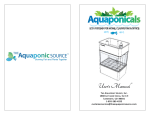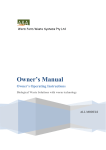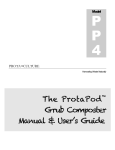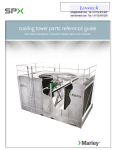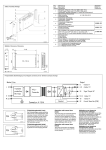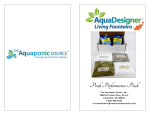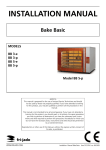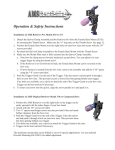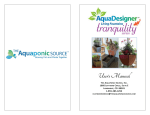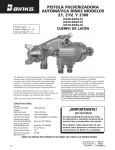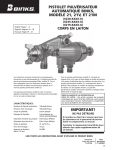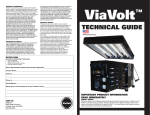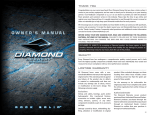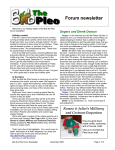Download File
Transcript
Leaders in Indoor Aquaponics 312 Aquaponics classes AP101: Home Eco-System Implementation Home eco-system user manual 1. Parts and Sourcing 2. Construction 3. Cycling 4. Maintenance 5. Common issues 312 aquaponics | visit us: 312ap.com | contact us: [email protected] | pg. 1 of 23 Leaders in Indoor Aquaponics parts: -100 gallon Rubbermaid stock tank: Grainger #1MD87; $137 - 18w Air Pump: B&G #PUDP-Group; $53 2x - 3'x3' Ebb and Flow tray: Brew and Grow #HT1-Group; $75 -1" Bulkhead: Aquatic Eco #tf3; $7 - 10' of 1/2" Flexible tubing, B&G #ILS-Group; $.52 312 aquaponics | visit us: 312ap.com | contact us: [email protected] | pg. 2 of 23 Leaders in Indoor Aquaponics 2x - 1/2" Elbow, B&G # IFIT- Group; $.52 EA - 1/2” Tee, B&G # IFIT-Group; $.50 2x - 1/2" In Line Shut Off Valve: B&G #ISOV-Group; $6 - 14w submersible 4.5GPM@4' : aquatic-Eco #QP11; $26 - 4x - 6" air stone; B&G #PAUS-Group; $2 ea - 1/4" Airline; B&G #PUSAT-Group; $3 - 2ft of 1" PVC piping: Home Depot; $3 - 2ft of 3" PVC piping: Home Depot; $5 - 2ft of 6" PVC piping: FlexPVC.com; $27 -1” 90 deg Elbow: Home Depot #187984; $.50 312 aquaponics | visit us: 312ap.com | contact us: [email protected] | pg. 3 of 23 Leaders in Indoor Aquaponics - Tasco 3-Outlet Right-Angle GFCI Adapter: Home Depot #04-00101; $26 - ViaVolt 2 ft. 4-Bulb T5 High Output Fluorescent Grow Light Fixture: Home Depot: #202985194; $90 - 7w LED white t5 replacement: gogreensolar.com; $60ea - 24w Cool White 2ft t8 bulb: Home Depot #vt52b; $10ea - Light Hanger Kit: B&G #LMPG-Group; $19 3x - 50L bags of Hydrotonlivepage.apple.com: hydrowholesale.com #714120; $28 ea 312 aquaponics | visit us: 312ap.com | contact us: [email protected] | pg. 4 of 23 Leaders in Indoor Aquaponics 100G cycling startup kit: theaquaponicstore.com #akias0001a; $70 INCLUDES: -Aquaponics Explained video. -API Freshwater Master Aquarium Test Kit. - pH Up and pH Down Solutions - Digital Thermometer - Cycling Kit - Powdered, soluble pure ammonia - Powdered, soluble seaweed (same as Maxicrop) - Data Tracking Chart - Detailed instructions - beneficial Bacteria: petco #131288; $4 ! ! ! ! ! ! - Snyder Industries 3/4in. Garden Hose Valve with Adapter: Northern Tool #34701309; $15 - Makeup water dechlorination and Storage Tank: Sam’s Club #840752; $69 Note: You will need to store at least 15 gallons of DECHLORINATED water at all times. - 1 lb Red Wigglers: OrderWorms.com #RW1; $30 312 aquaponics | visit us: 312ap.com | contact us: [email protected] | pg. 5 of 23 Leaders in Indoor Aquaponics Optional Backup Power Fail Switch: (Highly Recommended) Backup Power Fail switch and leads USA standard; $145 MAKE SURE YOU BUY THE US VERSION! Attach this to a 12 Volt, Deep Cycle Marine Battery and a 12 Volt submersible pump. Pump - 12 volt x 500 gph with hose and hose fittings; $80 Submersible pump and fitting to be attached to the above backup Power Fail Switch and Deep Cycle Marine Battery. Duralast/685 CA marine deep cycle battery; $80 12 Volt battery to be connected to the above Pump and Switch then placed in a water-resistant container (disposable cooler, plastic storage container, etc). INSTRUCTIONS: Place pump in the corner of your stock tank and run its out flow pipe such that water will leave the stock tank and splash back down into the tank. 312 aquaponics | visit us: 312ap.com | contact us: [email protected] | pg. 6 of 23 Leaders in Indoor Aquaponics 312 aquaponics | visit us: 312ap.com | contact us: [email protected] | pg. 7 of 23 Leaders in Indoor Aquaponics Construction Disclaimer: Local Laws 312 Aquaponics LLC (312AP) is providing information for educational purposes only. The use of any information provided herein by any persons must comply with all relevant regulatory bodies, any use that does not do so is solely the concern of said persons and not the responsibility of 312AP. Follow Procedures 312AP has done the best it can to provide a safe, complete, and clear learning environment. The equipment and parts suggested by 312AP have been chosen specifically for safety considerations. Any deviations from our provided parts list and procedures will increase the risk of personal injury and property damage. Cutting Corners An aquaponic eco-system is an advanced mechanical system as well as a biological eco-system. This means that any practitioner must do their best to upkeep their eco-system and be willing to take all steps necessary to safely maintain their aquaponic eco-system. The following tips should be followed for safety purposes: -Please wear the proper safety gear when working with power tools. -Please follow all safety procedures when working with power tools. -Please only use equipment tested by Underwriter's Laboratory. -Please use Ground-Fault Circuit Interrupter (GFCI) extension cords whenever you need to plug equipment into your home outlet. -Please make sure your equipment is running on electrical lines that can handle 20amps. -Please ensure the immediate vicinity of your aquaponic eco-system is safe from the following hazards: -Fires (don't place flammable materials nearby) -Floods (have a route available for spilled water) -Dead fish (have a means of disposal for dead plants and fish) -Mold (ensure proper ventilation for your aquaponic eco-system). 312 aquaponics | visit us: 312ap.com | contact us: [email protected] | pg. 8 of 23 Leaders in Indoor Aquaponics Tools: • Drill (12V+ if cordless) • 1 3/4" hole bit • 1/4" and 1/8" drill bits • PVC pipe cutter and/or PVC hand saw and clamp • PVC glue and primer • Plumbing tape • Silicon Caulk Tube (for kitchen uses) • Caulk gun • Plumber's trap wrench (for 2"+ fittings) 312 aquaponics | visit us: 312ap.com | contact us: [email protected] | pg. 9 of 23 Leaders in Indoor Aquaponics Procedure: 1. Map out a space for your eco-system. With two trays, it takes up a 10’ by 3.5’ box. But you’ll need ample space around it for maintenance, harvesting, and planting. a. Also keep in mind the possibility of expansion... 2. Place stock tank in center of your mapped out space. Replace drainage plug with 3/4” garden hose valve, turn to OFF position. a. Point the drainage port on the tank towards the closest. If it’s far, you can attach a hose to your stock tank and run it to the nearest drain. b. If this is not possible, you can attach a garden hose to your sump pump to drain your stock tank when needed. 3. Place your cinder blocks as depicted in the picture. Cut and place 1”x8” boards as shown: 312 aquaponics | visit us: 312ap.com | contact us: [email protected] | pg. 10 of 23 Leaders in Indoor Aquaponics 4. Drill a 1 3/4” hole with your hole saw in the tray. a. Make sure to check the underside of your desired hole location to ensure that the bulkhead’s nut will fit: 5. Place the body of the bulkheads such that the nut is on the underside of the tray and gasket is on the upper side of the tray: 312 aquaponics | visit us: 312ap.com | contact us: [email protected] | pg. 11 of 23 Leaders in Indoor Aquaponics 6. Tighten with your hands until you cannot. Then tighten no more than 1/2 turn more with wrench to ensure you don’t damage the gasket b. Here is a nice forum post on bulkheads. c. Bulkhead Diagram: 7. Place trays down on cinder blocks. a. Line them up as shown to reduce strain and maintain leveled trays, keeping your auto bell syphons working properly: 8. Cut and arrange your bell syphon kits. See: HOME ECO-SYSTEM DIGRAM.PDF for more detailed diagrams. 312 aquaponics | visit us: 312ap.com | contact us: [email protected] | pg. 12 of 23 Leaders in Indoor Aquaponics a. Don’t use glue! 7. Place Air Pump in desired location: 8. 9. Measure and cut airlines to length, attach to air stones and air pump, place in stock tank: 312 aquaponics | visit us: 312ap.com | contact us: [email protected] | pg. 13 of 23 Leaders in Indoor Aquaponics 9. Insert 1” PVC drainage pipe. 10. Cover 1” drainage pipe with 3” bell syphon (make sure it has the holes in it) and place 3” cap on it. 11. Place 6” PVC guard over 3” bell syphon, push as far away from the stock tank as possible and place 6” cap on it: 312 aquaponics | visit us: 312ap.com | contact us: [email protected] | pg. 14 of 23 Leaders in Indoor Aquaponics 12. Place pump in stock tank. 12. Cut 1/2” flexible tubing (~3ft) to go from pump to just above the top of the trays. 13. Insert 1/2” Tee. 14. Cut 1/2” flexible tubing (2x ~3ft sects) to run from the Tee to the outer edge of the trays. 15. Insert 1/2” shut off valves: 16. Fill stock tank with 100G-120G (16”-20”) of water. 17. Surround the bell syphon guard with 3/4” gravel, filling the entire corner of the tray. a. This ensures that the bell syphon assemble does not become easily nocked loose and that no hydroton enters the assembly from the channels that run along the bottom of the tray: 312 aquaponics | visit us: 312ap.com | contact us: [email protected] | pg. 15 of 23 Leaders in Indoor Aquaponics 19. Test Flood and drain times. a. Flood times should between 10-20mins. b. Drain times should be between 2-4mins. 20. Fill with hydroton to 1” from the top lip of the tray. a. Ensure that you have 1”-2” of clearance between the maximum water height and the top layer of hydroton: 21. Test flood and drain times again, adjusting the adapter ontop of your 1” drain pipe if necessary. 22. Wash your hydroton in your trays (if you haven’t already). 23. Turn on air pump, and let your eco-system run over night. 24. If you followed step 23, drain your eco-system, clearing as much red dust from the bottom of your stock tank as possible and refill. 25. Let the eco-system run for another 24 hours. 26. Begin fishless cycling! 312 aquaponics | visit us: 312ap.com | contact us: [email protected] | pg. 16 of 23 Leaders in Indoor Aquaponics Cycling: 312 Aquaponics vehemently suggests "fishless cycling." - The Aquaponic Source on fish less cycling. By introducing prepackaged bacteria along with nutrients suitable for their growth (prepackaged ammonia), you can create a robust set of beneficial bacteria colonies before you add your fish. Then, once the fish are introduced, your eco-system will have ample bacterium to process any fish waste as it is produced. This takes stress off your fish, saves you time, and limits the possibility of catastrophic swings in ammonia and nitrate. 1. Complete eco-system buildout (see construction manual section). 2. Determine suitable "flood and drain" timing (10-30min for full flood and drain). 3. Rinse hydroton (not necessary, but encouraged) 4. Fill trays to top rim with hydroton. 5. Fill with tap water. 6. Add "Dechlor." 7. Wait 24-48hrs 8. Add cycling kit + bacterium into stock tank, stir water thoroughly. 9. Wait 15mins. 10. Test ammonia, nitrite, and nitrate and record. 11.Let eco-system run over night. 12. Test all three twice a day. 13. When ammonia decreases and nitrate "spikes," add .5lbs worms into each tray. 14. Testing twice daily, once your nitrates drop, add 50g of crushed fish food pellets. 15.Test twice daily, looking for: A. An ammonia spike, B. An ammonia drop and nitrate spike, and C. A nitrate drop and nitrite spike. And that's it, you can add your fish! 312 aquaponics | visit us: 312ap.com | contact us: [email protected] | pg. 17 of 23 Leaders in Indoor Aquaponics Cycling Schedule: 312 aquaponics | visit us: 312ap.com | contact us: [email protected] | pg. 18 of 23 Leaders in Indoor Aquaponics Tips: Fish Salt Bathes To ensure that you are not introducing any common pathogens, create a separate tank in which you add 4 teaspoons of salt per Gallon of water. Place your fish into the salt bathe for 30 mins. Feed Feed 50g-83g per 3ft by 3ft flood-and-drain tray per day. Start low, and push it only if your eco-system can handle it. Like humans, it is better for the fish to eat less per meal but more meals, so try to feed 2-3 times a day instead of one big meal. Also, watch how much your fish eat in 5 minutes. If there is any feed left after that, you've most likely over fed. pH Once you have fish in your eco-system, you must test pH daily. Every aquaponic eco-system becomes increasingly acidic over time. To correct this, add "pH Up" once daily. NO MORE THAN ONCE DAILY! If the pH moves too much in one day, your fish will die. Worms Feed Your aquaoponic eco-system is not a pure vermiculture setup, so you must treat it accordingly. So, no meat, dairy, eggs, citrus, or oily stuff. Do give them: greens and vegetables. Procedure: cut, chop, dice, or rip your food up and burry it just underneath the surfa of your hydroton. Wait 24 hours and check the same spot to see if your worms like what you put there. If so, carry on. 1-3 handfuls once a week per tray. 312 aquaponics | visit us: 312ap.com | contact us: [email protected] | pg. 19 of 23 Leaders in Indoor Aquaponics Maintenance Daily: •Test water for temperature, pH, ammonia, nitrite, nitrate. •Feed fish 50g-85g (1.75oz-3.5oz) per tray per day. • Start low, work up; watch how much they eat in the first 5 minutes. • Feed 2-3 times daily. •Pick up dead leaves. •Look for bugs. -If you see aphids, white flies, or spider mites, introduce lady bugs ($15). ! [From left to right, aphids, white flies, spider mites] (Here is a wonderful presentation by Molly Stanek of Imagine Aquaponics on Integrated Pest Management [IPM]) •Look for mold or powdery mildew.-If you see mold, spray the affected area with Serenade Garden or a mixture with Hydrogen Peroxide (below). 312 aquaponics | visit us: 312ap.com | contact us: [email protected] | pg. 20 of 23 Leaders in Indoor Aquaponics Weekly: •Check pump filters. •Water level/volume in tanks. - Add enough makeup water to bring the eco-system back to normal levels, ~15 gallons a week. Monthly: • Brush floor in fish tank, gently knocking it loose so that it can be sent to the grow beds. • Check back up system air if you have it. 312 aquaponics | visit us: 312ap.com | contact us: [email protected] | pg. 21 of 23 Leaders in Indoor Aquaponics Common Issues Pump stops working. Common causes: - Pump filter is clogged. Clean it. - Pump burned out because it ran dry. Replace it. - Circuit fuse was blown due to too much power draw. Replace fuse, run equipment on multiple circuits. - A pipe is clogged with debris. Clean it. Fish are dying. Common Causes: - Temperature dropped too low, bacteria not processing efficiently enough. Increase temperature to 75degrees for 1 week. - Chlorinated water got into eco-system, killed off bacteria. Increase temperature to 75degrees for 1 week - Tank is over crowded and fish are fighting. Take fish out to ensure all fish are about the same size. - Fish are not getting enough food and are fighting. Feed more. - Unknown pathogen is in water, harming fish. Restart you ecosystem. Plants are dying. Common causes: - Not enough nutrients in water. Add 1 tablespoon of maxicrop, feed more. - Bacteria are not processing fish waste efficiently enough. Increase temperature to 75degrees for 1 week - Lights are too low, on too long. Increase distance from light to canopy, change lighting cycle. - Mold or powdery mildew on plants. Spray with Serenade Garden or a mixture of Hydrogen Peroxide and water, increase ventilation in space. - Aphids, spider mites, white flies infesting plants. Introduce lady bugs. Air is uncomfortably humid. Common causes: - Not enough air flow in and out of space. Increase air flow! 312 aquaponics | visit us: 312ap.com | contact us: [email protected] | pg. 22 of 23 Leaders in Indoor Aquaponics 312 aquaponics | visit us: 312ap.com | contact us: [email protected] | pg. 23 of 23

























